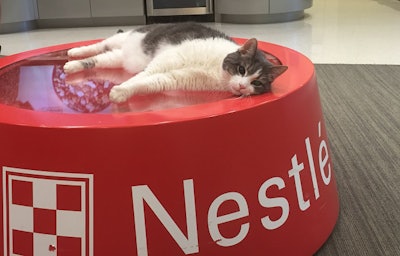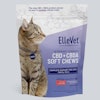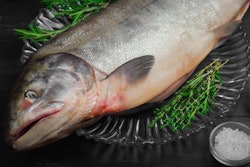
How long does it take for a pet nutrition concept to be thoroughly researched and developed into a pet food product? If the company doing the research is Nestlé Purina PetCare, it may take from one to as long as 14 years. The key here is “thoroughly”; Purina won’t go to market with a product unless it’s sure the science-based research is robust and will provide optimal nutrition for dogs or cats.
That was one of the key messages pervading Purina’s Behind the Bowl symposium, a two-day event the company hosted for invited members of the media, including yours truly, the week of September 11. The other major message? Purina wants to be more transparent, especially with consumers, and company representatives admitted they perhaps have not always been that open about telling their story. The company’s latest tagline, “Your pet, our passion,” originated in part because “we think we forgot to talk about our passion,” said Daniel Henke-Cilenti, director of marketing for Purina.
Hence, the outreach to media as one avenue to connect with consumers. Many of the media brands represented have consumer audiences – interestingly, Purina invited several that are not pet focused, including Shape, Eating Well, Family Circle, Parents and Martha Stewart Living. Remaining guests hailed from pet-centric portals for consumers like Petcha and PetHub, or from trade publications reaching pet retailers (Pet Product News, Pet Business, Pet Age) and even grocers (Supermarket News, Progressive Grocer). Purina’s plan for the event apparently involved reaching multiple audiences.
Focus on pet food research and science
Henke-Cilenti framed the two days of discussion and demonstration around Purina’s three “pursuits”: passion, safety and innovation. But the latter area really flows from the company’s extensive research, and its determination to promote that research to consumers is noteworthy in this age where many people seem to distrust or not believe in the importance of science.
At least one Purina executive believes veterinarians can help counter this and the misconceptions that many consumers believe about pet food. “Vets often have to dispel myths that pet owners are finding on the internet,” said Kurt Venator, DVM, PhD, chief veterinary officer and a practicing vet in upstate New York, USA. He tells vets he talks to that they must be the “bearer of nutrition facts and science.” He said he thinks vets have slipped in this mission, letting others take over delivering nutrition education and information, and he believes Purina should play a strong role in supporting vets in the effort.
In response to my question about general consumer distrust of science and whether most veterinarians have the nutrition knowledge to help dispel myths, Venator indicated that because vets are trained to seek evidence-based medicine and science, providing them with that information is helping. “The most common questions vets get today are about nutrition and behavior,” he said. “I think the pendulum is swinging to where vets are educating themselves more, seeing this as part of their job. We go into vet schools, especially ones where they don't have board-certified nutritionists, and give unbiased research. I think it’s getting better,” he added, referring to vets’ knowledge of pet nutrition.
Imagine this for dogs or cats
All the research generated by Purina springs from a vast staff of scientists, nutritionists and veterinarians who are challenged to approach their work with “imagine” statements, according to Dan Smith, vice president of R&D.
An example he offered: “Imagine if we could help older dogs with cognitive dysfunction syndrome.” That led to 14 years of research, involving several rounds, each with increasing funding, that ultimately resulted in Purina Pro Plan Bright Mind. This food for dogs 7 years and older includes medium chain triglycerides (MCTs), fatty acids derived from botanical oils, which provide an energy source for the brain. Purina’s extensive research proved that the MCTs promote alertness and mental sharpness in older dogs, even ones already showing signs of cognitive decline.
While the Bright Mind research timeline was the longest cited by Smith, a multi-year development project is not at all uncommon for the company. One of its newest products, this one for cats 7 years and older (Pro Plan Prime Plus), involved a nine-year study. (Smith also commented that the company is researching a version of Bright Mind for cats.)
An older product, the FortiFlora probiotic supplement line (available only through veterinarians), took more than eight years to develop – yet that still represented cutting-edge research when it launched 11 years ago, because at that time probiotics weren’t trendy or well known to be beneficial to human or pet health. (Purina included supplies of FortiFlora in its recent shipment of donations for victims of Hurricane Irma, as company research has shown the probiotic to help relieve symptoms from stress.)
Those are just a few examples of the company’s research and product development process presented by Smith and his colleagues. In fact, he provided the first information on a new Purina product line for both dogs and cats launching in January 2018: SimplyFit, a kit of two separate pet foods in one box, based on research showing that weight loss and optimum weight may be better obtained via intermittent calorie reduction. One of the foods is less energy dense than the other; and the key to potential success could be that the owner will feed the same amount of each food. The company’s data to date is showing up to 50 percent more efficient weight reduction than with straight-out caloric restriction, Smith said.
The proof is in what their pets eat
Other Purina representatives demonstrated how the company carries out its commitment to quality and safety; stay tuned for an overview soon. For now, back to the passion element: Specific to its research, Smith said the company does not always patent its findings or keep them proprietary; if his team believes the research will readily benefit all pets, they will publish it publicly (in peer-reviewed journals) to ensure all pet food companies, including competitors, can use it. An example offered was Purina research from several years ago showing that for optimal pet nutrition, it’s the protein-to-calorie ratio in the pet food that’s important, not the amount of protein on its own.
Another sign of that passion: nearly every staff member we met has worked at Purina for multiple years, if not decades, and in some cases their children and other family members now work there, too. Despite being a very large multinational company with an even larger parent company, several people commented that to them, Purina still feels like a small, family company, full of people who love pets. “These products are made by pet owners in a community of pet owners; we feed these products to our own pets,” Henke-Cilenti said.


















